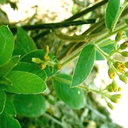Antibacterial and anti-inflammatory effects of extracts and fractions from Polygonum capitatum.
Keywords
Abstract
OBJECTIVE
This study was designed to investigate the antibacterial and anti-inflammatory activities of the extracts and the structure-based fractions from P. capitatum so as to provide the evidence for the traditional use of this plant in the treatment of urinary tract infections and to clarify the structural types that were responsible for the clinical use of the plant.
METHODS
The dry whole plant of P. capitatum was extracted with water and 70% aqueous ethanol and then separated, respectively, into a fraction enriched in polysaccharides and proteins (PP) and four other fractions enriched in gallic acid and its analogues (GAA), flavonoids (FV), tannins (TN), and triterpenoids and steroids (TS). UV spectral or chemical methods were used for the confirmation of the five fractions. The in vitro antibacterial activities of the aqueous (AE) and 70% aqueous ethanol (70EE) extracts as well as the fractions against gram-positive and gram-negative bacteria were initially evaluated by a disc diffusion test. The anti-bacterial potencies of the active extracts or fractions were then assessed in vitro by determining the MICs and MBCs. The anti-inflammatory activity was evaluated employing the xylene-induced mouse ear edema model.
RESULTS
Except for fraction PP, AE, 70EE, and the four fractions (GAA, FV, TN, and TS) exhibited varying degrees of antibacterial and anti-inflammatory activities. The results of the minimal inhibition concentration (MIC) and minimal bactericidal concentration (MBC) indicated that the crude extracts or fractions FV and TN all possess bacteriostatic and bactericidal properties. Fractions FV and TS showed significantly anti-inflammatory activity (P<0.01) with the inhibition rates of 86.15 and 73.71% at 0.6g/kg, respectively, as compared to 76.93% of the positive control dexamethasone.
CONCLUSIONS
The overall results suggested that the traditional use of this plant for the treatment of urinary tract infections were attributed to the presence of antibacterial and anti-inflammatory agents. The results also provided evidence that the studied plant extracts, as well as some of the fractions obtained from this plant might be potential sources for antimicrobial and anti-inflammatory drug development.




